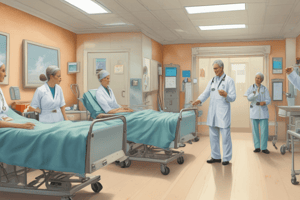Podcast
Questions and Answers
What is considered the normal oral temperature in Fahrenheit?
What is considered the normal oral temperature in Fahrenheit?
- 97.6 F
- 100.4 F
- 98.6 F (correct)
- 99.6 F
Which body fluid is NOT a potential carrier of HIV?
Which body fluid is NOT a potential carrier of HIV?
- Semen
- Saliva (correct)
- Blood
- Vaginal secretions
Which device is specifically used to measure blood pressure?
Which device is specifically used to measure blood pressure?
- Stethoscope
- Sphygmomanometer (correct)
- Oximeter
- Thermometer
What is the primary characteristic of passive immunity?
What is the primary characteristic of passive immunity?
Which of the following is a symptom of shock?
Which of the following is a symptom of shock?
What agency is responsible for regulating processing chemistry?
What agency is responsible for regulating processing chemistry?
What is the first stage of infection known as?
What is the first stage of infection known as?
What classification of asepsis helps reduce the number and spread of microorganisms?
What classification of asepsis helps reduce the number and spread of microorganisms?
What score is associated with a patient who opens their eyes to voice, has no motor response, and produces inappropriate verbal responses?
What score is associated with a patient who opens their eyes to voice, has no motor response, and produces inappropriate verbal responses?
What is the drug name commonly used to control generalized seizures?
What is the drug name commonly used to control generalized seizures?
Which term refers to the name assigned to a drug by its manufacturer?
Which term refers to the name assigned to a drug by its manufacturer?
What law mandates the establishment of a Continuing Professional Development (CPD) council for regulated professions?
What law mandates the establishment of a Continuing Professional Development (CPD) council for regulated professions?
What are factors that may influence the effects of drugs?
What are factors that may influence the effects of drugs?
What is the term for learning that occurs in daily life and can contribute to qualifications?
What is the term for learning that occurs in daily life and can contribute to qualifications?
What does CPD stand for in the context of professional development?
What does CPD stand for in the context of professional development?
Who is the chairperson of the Continuing Professional Development (CPD) council?
Who is the chairperson of the Continuing Professional Development (CPD) council?
Which of the following is NOT a correct rule regarding surgical hand scrubbing?
Which of the following is NOT a correct rule regarding surgical hand scrubbing?
Which radiographic examination is least likely to use local anesthetics?
Which radiographic examination is least likely to use local anesthetics?
What is a recommended position for a patient suffering from orthopnea?
What is a recommended position for a patient suffering from orthopnea?
In which condition is a double contrast barium enema essential for demonstration?
In which condition is a double contrast barium enema essential for demonstration?
An example of subjective data obtained during a patient history is:
An example of subjective data obtained during a patient history is:
Which of the following is NOT a symptom of shock?
Which of the following is NOT a symptom of shock?
What is the salary grade for radiologic technology 2 in a public health center?
What is the salary grade for radiologic technology 2 in a public health center?
Which neurologic assessment tool is commonly used?
Which neurologic assessment tool is commonly used?
What is the medical term for the abnormal sensation of numbness?
What is the medical term for the abnormal sensation of numbness?
Which sign indicates a suspicion of deep vein thrombosis?
Which sign indicates a suspicion of deep vein thrombosis?
In which condition is protective or reverse isolation typically required?
In which condition is protective or reverse isolation typically required?
What is the correct term for a drug's chemical name?
What is the correct term for a drug's chemical name?
What should be followed while cleaning contaminated objects or surfaces?
What should be followed while cleaning contaminated objects or surfaces?
Which position should a patient experiencing syncope be placed in?
Which position should a patient experiencing syncope be placed in?
Which drug is considered a bronchodilator?
Which drug is considered a bronchodilator?
Which of the following drugs is used as a vasopressor for anaphylactic reactions?
Which of the following drugs is used as a vasopressor for anaphylactic reactions?
Flashcards are hidden until you start studying
Study Notes
Patient Care Management
- Rectal temperature is typically 99.6°F, while tympanic and oral temperatures are usually around 97.6°F and 98.6°F respectively; axillary temperatures also measure at 97.6°F.
- Radiographs are the property of the health care institution that produces them.
- Antiseptics are chemical substances that inhibit the growth of pathogenic microorganisms without necessarily killing them.
- HIV can be transmitted through body fluids such as blood, semen, and vaginal secretions.
- Blood pressure is commonly measured using a sphygmomanometer alongside a stethoscope.
- Symptoms of shock include increased pulse rate, restlessness, and apprehension.
- Airborne diseases include tuberculosis, mumps, and rubella.
- Ambulatory patients are individuals who are able to walk independently.
- Oxygen delivery must be prescribed by a physician and can be ordered for continuous use or as needed; it is classified as a drug.
- Material Safety Data Sheets (MSDS) provide guidelines for the safe use, handling, and disposal of hazardous materials.
- The Environmental Protection Agency (EPA) regulates the processing of chemicals.
- Pelvicalyceal visualization occurs approximately 2 to 8 minutes after the administration of contrast.
- Urinary tract infections are the most frequent site of nosocomial infections.
- Passive immunity is acquired through the injection of antibodies for a specific infection.
- The incubation period is the first stage of infection.
- Viruses are microorganisms that require a host cell for replication and are resistant to antimicrobial drugs.
- The optimal position for a patient with a tracheostomy is the semi-Fowler's position.
- Medical asepsis refers to practices aimed at reducing the number and spread of microorganisms.
- Surgical aseptic technique is unnecessary for procedures like gastrointestinal series.
- Aertropic is used as an anti-spasmodic in gastric disease.
- Paresthesia refers to the abnormal sensation of numbness.
- Homan’s sign is an indicator of suspected deep vein thrombosis.
- Protective or reverse isolation is required for patients with conditions like burns or leukemia.
- Examples of tissue drains include Hemovac and Penrose drains.
- The generic name is the chemical name assigned to a drug.
- Cleaning contaminated objects should follow guidelines: from the least to most contaminated area and from top down.
- Battery is the charge that can be filed against a radiographer performing an exam other than what was intended.
- Gerontologic patients often show physical changes like loss of bone calcium.
- Tracheostomy patients often struggle with speech and may need suction if they exhibit audible rattling sounds.
- An esophagogram is relevant for patients with esophageal disorders like varices or achalasia.
- Water-soluble iodinated media is recommended for GI series in suspected perforated ulcer cases.
- Proper care for tracheostomy patients includes using sterile techniques and limiting suctioning to 15 seconds.
- Patients who experience syncope should be placed in a dorsal recumbent position with elevated feet.
- The bevel is the angle of a needle's tip, while the hub connects the needle to the syringe; gauge refers to the needle's diameter.
- Epinephrine is classified as both a bronchodilator and vasopressor, often used in anaphylaxis and cardiac arrest.
- Germicides and disinfectants refer to substances that kill pathogenic bacteria.
- Consent forms are usually required for radiographic examinations like angiograms.
- Surgical hand scrubbing requires maintaining hands and forearms higher than the elbows and using antimicrobial agents.
- Local anesthetics are likely used in various radiographic examinations except post-operative or T-tube cholangiography.
- During a grand mal seizure, patients should be protected from injury.
- Patients with orthopnea may find relief in the Fowler's position.
- Double contrast barium enema is crucial for demonstrating polyps or colitis.
- Subjective data in patient history includes the patient’s self-reported symptoms such as extreme pain in certain positions.
- Symptoms of shock encompass pallor, weakness, and increased pulse rate.
- The chairman of the board of radiologic technology is Reynaldo Apollonio Tisado.
- Salary grades for radiologic technologists in public health centers vary from grade 12 for rad tech 1 to grade 22 for rad tech 5.
- Order of examinations typically performed include IVP, GB, BE, and UGI.
- GI and IVU examinations can be performed together as can GI and GB examinations.
- The Glasgow Coma Scale is used to assess neurologic function, with specific point values assigned to varying responses.
- Dilantin (phenytoin) is a common medication used for controlling generalized seizures.
- Trade name refers to the name given to a drug by its manufacturer.
- Factors influencing drug effects include medication history, patient temperament, age, weight, gender, and time of day.
- R.A. 10912 mandates a professional development program for regulated professions with a CPD council created for oversight.
- Continuing Professional Development (CPD) involves enhancing knowledge, skills, and ethical values post-licensure.
- The CPD council ensures continuous professional improvement in accordance with standards of practice.
- Informal learning refers to knowledge gained through life experiences that may contribute to qualifications.
- Prior learning encompasses skills and knowledge gained through work experience, training, and other activities potentially applicable for academic credit.
Studying That Suits You
Use AI to generate personalized quizzes and flashcards to suit your learning preferences.




